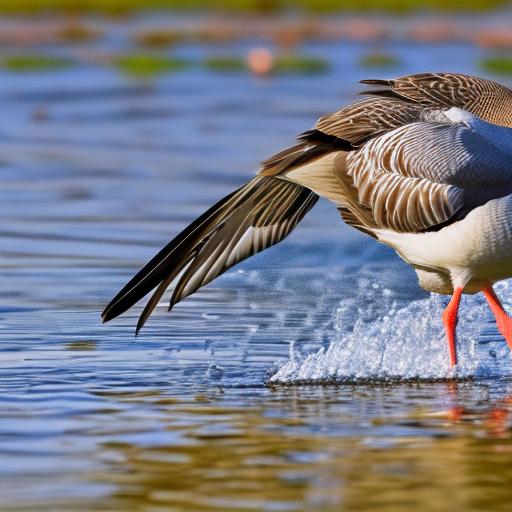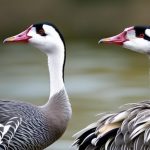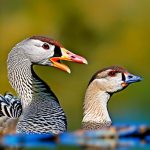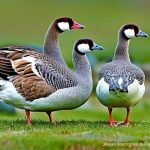Raising geese in a northern climate can be a rewarding and fulfilling experience. However, it also comes with its own set of challenges. The cold temperatures, harsh weather conditions, and limited food sources can make it difficult to keep geese healthy and thriving. In this article, we will explore the various aspects of raising geese in a northern climate and provide tips on how to overcome these challenges.
Key Takeaways
- Northern climates pose unique challenges for geese
- Choosing the right breed of geese is crucial for their survival in cold weather
- A safe and comfortable shelter is necessary for geese in freezing temperatures
- Providing adequate nutrition and managing water sources are essential for geese in cold weather
- Protecting geese from predators and addressing health concerns are important in a northern climate
Understanding the Northern Climate and Its Challenges for Geese
A northern climate is characterized by long, cold winters and short, cool summers. The temperatures can drop well below freezing, and snowfall is common. These conditions can pose several challenges for geese. Firstly, the cold temperatures can make it difficult for geese to regulate their body temperature. They may need extra insulation or protection from the elements to stay warm. Additionally, the limited food sources during winter can make it challenging for geese to find adequate nutrition.
Choosing the Right Breed of Geese for a Northern Climate
When raising geese in a northern climate, it is important to choose breeds that are well-suited for cold weather. Some breeds that are known to thrive in colder climates include Toulouse, Embden, and Pilgrim geese.
Toulouse geese are large and hardy birds that can withstand cold temperatures. They have a thick layer of down feathers that provide insulation and keep them warm during winter. Embden geese are also well-adapted to cold climates. They have a dense layer of feathers that protect them from the cold and wet conditions. Pilgrim geese are known for their ability to forage for food even in snowy conditions. They are excellent grazers and can find food sources even when the ground is covered in snow.
Creating a Safe and Comfortable Shelter for Your Geese
A shelter is essential for geese in a northern climate to protect them from harsh weather conditions. The shelter should be well-insulated and provide adequate ventilation. It should also be spacious enough to accommodate all the geese comfortably.
When building a shelter for your geese, consider using materials that can withstand the cold temperatures and provide insulation. Insulated panels or straw bales can be used to line the walls and roof of the shelter. Make sure to provide a dry bedding area for the geese to rest and sleep. This can be filled with straw or wood shavings.
Providing Adequate Nutrition for Your Geese in Cold Weather
Cold weather can affect the nutritional needs of geese. They require more energy to stay warm, so it is important to provide them with a balanced diet that meets their increased energy requirements.
During winter, it may be difficult for geese to find fresh grass and other natural food sources. Supplement their diet with high-quality feed that is specifically formulated for geese. This feed should contain a balance of protein, carbohydrates, vitamins, and minerals. Additionally, provide them with plenty of fresh water and ensure that it does not freeze.
Managing Water Sources for Your Geese in Freezing Temperatures
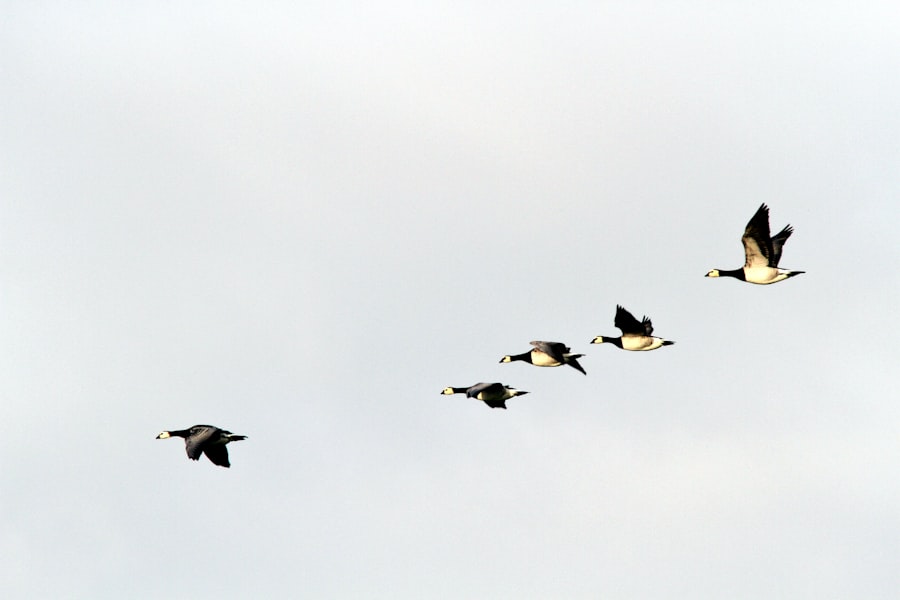
Water is essential for geese, even in freezing temperatures. They need water for drinking, bathing, and preening their feathers. However, it can be challenging to manage water sources during winter.
To prevent water from freezing, consider using heated waterers or installing a heating element in the water source. Alternatively, you can provide warm water multiple times a day to ensure that the geese have access to liquid water. It is also important to regularly check the water source and remove any ice that may have formed.
Preparing Your Geese for Winter with Proper Feeding and Care
Preparing your geese for winter involves several steps to ensure their health and well-being during the cold months. Here is a checklist of things to do:
1. Provide a well-insulated shelter with adequate ventilation.
2. Ensure that the geese have access to fresh water that does not freeze.
3. Supplement their diet with high-quality feed that meets their increased energy requirements.
4. Provide a dry bedding area for the geese to rest and sleep.
5. Monitor their health regularly and seek veterinary care if needed.
Proper feeding and care are crucial during winter to keep your geese healthy and thriving.
Protecting Your Geese from Predators in a Northern Climate
Geese may encounter predators in a northern climate, such as foxes, coyotes, and birds of prey. It is important to take measures to protect your geese from these predators.
One way to protect your geese is by providing a secure shelter that is predator-proof. Make sure that the shelter has a strong and sturdy fence or enclosure to prevent predators from gaining access. Additionally, consider using deterrents such as motion-activated lights or noise-making devices to scare away potential predators.
Addressing Common Health Concerns for Geese in Cold Weather
Geese may face several health concerns during winter, including frostbite, respiratory infections, and vitamin deficiencies. To prevent these health issues, it is important to provide proper care and attention to your geese.
Ensure that the shelter is well-insulated and provides adequate ventilation to prevent respiratory infections. Protect their feet from frostbite by providing a dry bedding area and regularly checking for signs of frostbite. Supplement their diet with vitamins and minerals to prevent deficiencies.
If you notice any signs of illness or discomfort in your geese, seek veterinary care immediately.
Keeping Your Geese Active and Engaged During Long Winters
Keeping geese active and engaged during winter is important for their physical and mental well-being. Lack of activity can lead to boredom and behavioral issues.
Provide your geese with plenty of space to roam and explore. Consider creating an enrichment area with toys, obstacles, and treats to keep them entertained. Additionally, spend time interacting with your geese and providing them with mental stimulation.
Preparing for Spring: Tips for Transitioning Your Geese from Winter to Spring
As winter comes to an end and spring approaches, it is important to prepare your geese for the transition. Here are some tips:
1. Gradually increase their outdoor time to allow them to acclimate to the changing weather.
2. Introduce fresh grass and other natural food sources slowly to prevent digestive issues.
3. Monitor their health closely during the transition period and seek veterinary care if needed.
Raising geese in a northern climate can be challenging but rewarding. By understanding the unique characteristics of a northern climate and taking the necessary steps to provide proper care and nutrition, you can ensure that your geese thrive even in cold weather. Share your own tips and experiences in raising geese in a northern climate to help others in their journey of raising these beautiful birds.
If you’re interested in keeping geese in a northern climate, you may also want to check out this informative article on “How Many Eggs Do Geese Lay?” It provides valuable insights into the breeding habits of geese and offers practical tips for maximizing egg production. Understanding the egg-laying patterns of geese is crucial for successful goose farming, and this article from Poultry Wizard is a great resource to help you get started. Read more here.
FAQs
What is the best breed of geese for a northern climate?
The best breed of geese for a northern climate is the Embden goose. They are hardy and can withstand cold temperatures.
What kind of shelter do geese need in a northern climate?
Geese need a shelter that is well-insulated and draft-free. It should also be large enough to accommodate all the geese and provide them with enough space to move around.
What do geese eat in a northern climate?
Geese can eat a variety of foods in a northern climate, including grains, grasses, and vegetables. They also need access to clean water at all times.
How do you keep geese healthy in a northern climate?
To keep geese healthy in a northern climate, it is important to provide them with a balanced diet, clean water, and a clean living environment. They should also be vaccinated against common diseases.
What are some common health problems that geese face in a northern climate?
Geese in a northern climate are susceptible to respiratory infections, frostbite, and hypothermia. It is important to monitor their health closely and seek veterinary care if necessary.
Can geese survive in a northern climate without a pond?
Geese can survive in a northern climate without a pond, but they still need access to clean water for drinking and bathing. A large water trough or bucket can be used instead of a pond.
Meet Walter, the feathered-friend fanatic of Florida! Nestled in the sunshine state, Walter struts through life with his feathered companions, clucking his way to happiness. With a coop that’s fancier than a five-star hotel, he’s the Don Juan of the chicken world. When he’s not teaching his hens to do the cha-cha, you’ll find him in a heated debate with his prized rooster, Sir Clucks-a-Lot. Walter’s poultry passion is no yolk; he’s the sunny-side-up guy you never knew you needed in your flock of friends!

